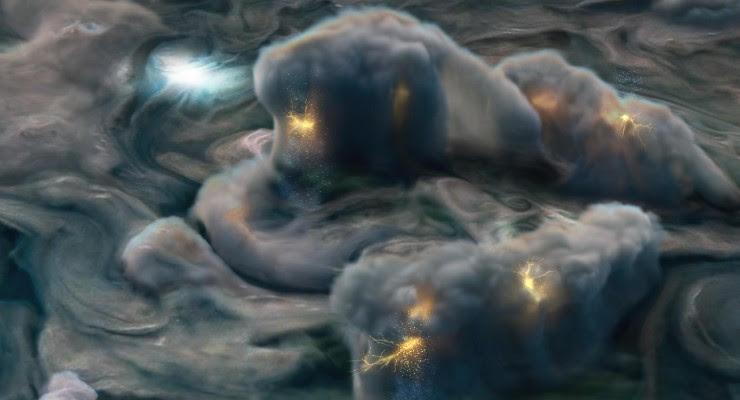
This illustration, created using data from NASA’s Juno mission, depicts high-altitude electrical storms on Jupiter. (Credit: NASA/JPL-Caltech/SwRI/MSSS/Gerald Eichstädt)
Researchers studying data from the Jet Propulsion Laboratory’s Juno spacecraft unveiled new findings on Wednesday — the 9th anniversary of the mission’s launch — including a surprising new form of “shallow lighting” high in Jupiter’s atmosphere, as well as “mushballs” of hail made from ammonia and water.
The discoveries are already helping scientists better understand the weather and climate of the solar system’s most massive planet, JPL officials said in a written statement. But the new data has implications that reach even farther than Jupiter.
“Understanding the meteorology of Jupiter enables us to develop theories of atmospheric dynamics for all the planets in our solar system, as well as for the exoplanets being discovered outside our solar system,” according to the statement. “Comparing how violent storms and atmospheric physics work across the solar system allows planetary scientists to test theories under different conditions.”
Lighting has been observed on Jupiter before, but it has always been assumed that it was similar to lightning on Earth, “occurring only in thunderstorms where water exists in all its phases — ice, liquid, and gas,” the JPL statement explained. But that can only happen deep within Jupiter’s clouds, where it’s warm enough for water to exist as liquid.
“Juno’s close flybys of the cloud tops allowed us to see something surprising — smaller, shallower flashes — originating at much higher altitudes in Jupiter’s atmosphere than previously assumed possible,” said Heidi Becker, lead of Juno’s radiation monitoring investigation at JPL. Becker is also the lead author of a paper on the subject that is scheduled to appear in the journal Nature on Thursday.
At 126 degrees below zero, temperatures at the high altitudes where lighting was spotted by Juno are far too cold for liquid water, researchers said. The answer to the puzzle turned out to ammonia.
“At these altitudes, the ammonia acts like an antifreeze, lowering the melting point of water ice and allowing the formation of a cloud with ammonia-water liquid,” Becker said. “In this new state, falling droplets of ammonia-water liquid can collide with the upgoing water-ice crystals and electrify the clouds. This was a big surprise, as ammonia-water clouds do not exist on Earth.”
Scientists on the Juno teams also discovered another strange weather phenomenon on Jupiter in the form of “mushballs” of hail made from a mixture of water and ammonia. The work has appeared in a paper in the Journal of Geophysical Research: Planets.
The finding solved a mystery created by Juno’s observations earlier in its mission, according to JPL.
“Juno’s microwave radiometer instrument discovered that ammonia was depleted — which is to say, missing — from most of Jupiter’s atmosphere,” the JPL statement said. “Even more puzzling was that the amount of ammonia changes as one moves within Jupiter’s atmosphere.”
By discovering the process through which the ammonia-water hailstones form, the mystery of the missing ammonia may be solved.
“Previously, scientists realized there were small pockets of missing ammonia, but no one realized how deep these pockets went or that they covered most of Jupiter,” according to Scott Bolton, Juno principal investigator, of the Southwest Research Institute in San Antonio.
“We were struggling to explain the ammonia depletion with ammonia-water rain alone, but the rain couldn’t go deep enough to match the observations,” he said. “I realized a solid, like a hailstone, might go deeper and take up more ammonia. When Heidi discovered shallow lightning, we realized we had evidence that ammonia mixes with water high in the atmosphere, and thus the lightning was a key piece of the puzzle.”
Looking at both recent discoveries, the anwer emerged.
“Combining these two results was critical to solving the mystery of Jupiter’s missing ammonia,” Bolton said. “As it turned out, the ammonia isn’t actually missing; it is just transported down while in disguise, having cloaked itself by mixing with water. The solution is very simple and elegant with this theory: When the water and ammonia are in a liquid state, they are invisible to us until they reach a depth where they evaporate — and that is quite deep.”










